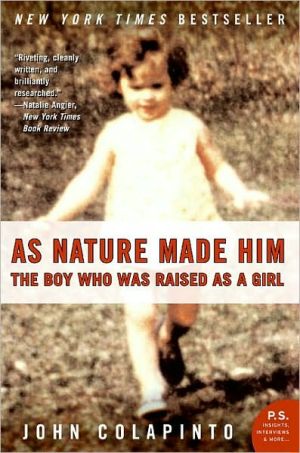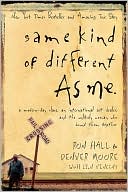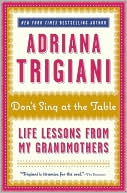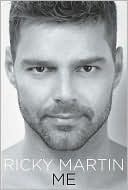As Nature Made Him: The Boy Who Was Raised as a Girl
In 1967, after a twin baby boy suffered a botched circumcision, his family agreed to a radical treatment that would alter his gender. The case would become one of the most famous in modern medicine—and a total failure. As Nature Made Him tells the extraordinary story of David Reimer, who, when finally informed of his medical history, made the decision to live as a male. A macabre tale of medical arrogance, it is first and foremost a human drama of one man's—and one family's—amazing survival...
Search in google:
In 1967, after a baby boy suffered a botched circumcision, his family agreed to a radical treatment. On the advice of a renowned expert in gender identity and sexual reassignment at Johns Hopkins Hospital, the boy was surgically altered to live as a girl. This landmark case, initially reported to be a complete success, seemed all the more remarkable since the child had been born an identical twin: his uninjured brother, raised as a boy, provided to the experiment the perfect matched control.The so-called twins case would become one of the most famous in modern medicine and the social sciences; cited repeatedly over the past thirty years as living proof that our sense of being male or female is not inborn but primarily the result of how we are raised. A touchstone for the feminist movement, the case also set the precedent for sex reassignment as standard treatment for thousands of newborns with similarly injured, or irregular, genitals.But the case was a failure from the outset. From the start the famous twin had, in fact, struggled against his imposed girlhood. Since age fourteen, when finally informed of his medical history, he made the decision to live as a male. John Colapinto sets the historical and medical context for the case, exposing the thirty-year-long scientific feud between Dr. John Money and his fellow sex researcher, Dr. Milton Diamond - a rivalry over the nature/nurture debate whose very bitterness finally brought the truth to light. USA Today - Deirdre Donahue Beautifully read by Howard McGillin, As Nature Made Him contains a powerful lesson about the importance of questioning the big authorities and of listening to small children.
Chapter One\ A Game of Science Fiction\ The irony was that Ron and Janet Reimer's life together had begun with such special promise. That it would survive its trials is attributable perhaps in part to their shared heritage in an ethnic and religious background virtually defined by the hardiness of its people in the face of suffering.\ Both Ron Reimer and Janet Schultz were descended from families who were Mennonite, the Anabaptist sect founded in sixteenth-century Holland. Like the Amish, Ron's and Janet's Mennonite ancestors were pacifists who followed a simple, nonworldly life based directly on Christ's teachings in the Sermon on the Mount. During the Inquisition, Mennonites were tortured and slaughtered in the thousands, the survivors escaping to begin a three-hundred-year search for a country that would allow them to live as a culture and religion apart. The majority went to Russia and farmed, but in the late 1800s, large numbers began to migrate to the New World, some settling in Nebraska and Kansas. The densest concentrations, however, settled in Canada, where the federal government, eager to populate its empty western plains, offered to the Mennonites complete religious freedom, their own schools, and exemption from military service. The first Mennonites arrived in southern Manitoba in 1874. Within five years, over ten thousand had followed, transplanting entire Russian villages to the Canadian prairie. It was in this wave of immigrants that both Ron's and Janet's great-grandparents, who were Dutch Mennonites directly descended from the earliest followers of the sect, came to Manitoba.\ Their arrivalcoincided with that moment when the Canadian Pacific Railway reached Winnipeg, and transformed the once tiny and isolated fur-trapping settlement and Hudson's Bay trading post. Within three decades the settlement had become a major grain capital of the North American middle west. "All roads lead to Winnipeg," the Chicago Record Herald reported in 1911. "It is destined to become one of the greatest distributing commercial centers of the continent as well as a manufacturing community of great importance."\ Though the city failed to live up to those grand predictions, Winnipeg did grow rapidly in size, sophistication, and importance over the first half of the twentieth century, establishing the country's first national ballet company and symphony orchestra. Today its population is over 600,000, and the city's downtown core, built around the meandering curves of the Red River, boasts an impressive stand of modern high-rises to complement its fine Victorian buildings.\ The Mennonites on the surrounding prairies had long felt the lure of Winnipeg's affluence, and after World War II the more assimilated families began to move into the city to take jobs in manufacturing, trucking, and construction. Among them were Ron Reimer's parents, Peter and Helen, who in 1949 sold their farm in nearby Deloraine and moved to the Winnipeg neighborhood of St. Boniface, where Peter took a job in a slaughterhouse and Helen raised their four young children, of whom Ron was the eldest.\ Even as a small child, he was dutiful and hardworking, a boy whose combination of personal privacy and dogged industry often amazed his own mother. "He was always so shy and quiet," Helen Reimer recalls, "but he was also such a busy little boy. I had to think up ways to keep him out of trouble. I would show him how to cook. He always wanted to be doing something with food and cooking." It was a passion that would stay with Ron. As an adult he would eventually support his wife and two children by running his own business as the operator of a coffee truck, supplying sandwiches and other prepared foods to construction sites around Winnipeg.\ By 1957, when Ron was in his early teens, the music of Elvis Presley, Chuck Berry, and Little Richard had reached Winnipeg. Cars, girls, beer, and rock 'n' roll music soon had strong claims on his attention. For Mennonites of Ron's parents' generation, the swift cultural changes of the late 1950s were threatening. Though not themselves especially devout, they had only a decade earlier moved from an almost exclusively Mennonite farm community where some of the day-to-day values and assumptions were still closer to those of nineteenth-century rural Russia than late-twentieth-century urban North America. In what would prove to be a kind of reverse migration, the Reimers were among many Mennonite families who, in an effort to resist the seismic cultural shifts taking place in the city, returned their families to their roots on the prairie. In 1959, Ron's father bought a farm some sixty miles from the city, near the town of Kleefeld, in Mennonite country, and moved his family there.\ Ron, fifteen years old at the time, hated the move. Kleefeld itself was little more than a ramshackle scattering of stores along a few hundred yards of gravel highway (grain store, post office, grocery), with nowhere for Ron to channel his formidable work ethic. He would pick two hundred pounds of saskatoons and sell them for twenty-five cents a pound--grueling labor for little pay; nothing like the money he was able to make in the city. And his father insisted on taking even those paltry sums from Ron for upkeep of the old clapboard farmhouse on its patch of scrubby land.\ It was in this state of boredom, penury, and growing friction with his strict and authoritarian father that Ron, at seventeen, accepted the invitation of his friend Rudy Hildebrandt to visit Rudy's girlfriend in the nearby town of Steinbach. Rudy's girlfriend had a nice-looking roommate, a girl named Janet, whom Ron might like.\ Like Ron, Janet Schultz was raised in Winnipeg, the eldest child of Mennonite parents who had....\ As Nature Made Him. Copyright © by John Colapinto. Reprinted by permission of HarperCollins Publishers, Inc. All rights reserved. Available now wherever books are sold.
\ From Barnes & NobleNature vs. Nurture \ In As Nature Made Him, author John Colapinto offers a powerful true story that may shake beliefs you take for granted -- not least that doctors can be trusted to work in their patients' best interests. In lucid, impassioned prose, Colapinto, a Pulitzer Prize-winning journalist, traces the life of David Thiessen, a boy sex-changed to female during infancy as part of a cruel experiment. In 1965, David (then named Bruce) was one of a pair of male twins. After a catastrophic circumcision accident, Bruce's penis was destroyed, while his brother Brian remained intact. Devastated, the twins' parents turned for help to Dr. John Money, a world-famous Johns Hopkins psychologist. They were searching for a solution. Instead, they found themselves pawns in a test designed to confirm Money's pet theory -- that gender is a purely social phenomenon, a matter of nurture, not nature.\ Indeed, for 20 years, the doctor touted the success of the so-called "John/Joan" case. The surgically created girl, he claimed, had grown up contentedly feminine, in contrast to her rough-and-tumble brother. She fulfilled numerous stereotypes: shy, neat, and pretty, she loved babies and cooking. Most importantly, she considered herself a girl and seemed female to others. Gender, Money announced, was malleable. This finding was hugely influential, seized upon by everyone from feminist academics to pediatricians. And Money, already extremely powerful, rose to the top of his field, wielding enormous influence over surgeons and psychologists alike.\ The real story did not emerge until many years later. For in fact, "Brenda" (the name the infant was given after surgery) had never felt female -- and was not perceived as a girl by others. Tormented by her peers, she was nicknamed "cavewoman" and sneered at for her mannish gait. She regularly got into brawls and was failing academically. Even the few bonds the unhappy child formed with tomboys were fragile, since she was perceived not as a tough girl but as a boy in a dress. In her teens, Brenda became suicidally depressed. She refused to go back to see Dr. Money, with whom she'd had annual visits until the age of 14. And she began to dress as a boy. Finally, her parents broke down and told her the truth. "More than anything else," David recalls of this revelation. "I was relieved. Suddenly it all made sense why I felt the way I did."\ "Brenda" reverted to male. He had surgery to create a cosmetic penis and therapy to deal with his rage and depression. He changed his name to David, a reference, in part, to the biblical figure who slew a giant. Eventually, he married a loving woman with three children by other fathers. But all the while, the scientific theory supposedly based on his experience continued to guide medical protocols. Money claimed that the family had been "lost to follow-up" -- despite the fact that they never moved or changed their phone number. The case had special influence on the treatment of intersexed (that is, hermaphroditic) infants, who were increasingly "normalized" to female, despite evidence that, like Thiessen, many such children feel traumatized by the surgery and grow up to reject their gender. Finally, in 1996, biologist Milton Diamond, a longtime professional enemy of Money, tracked Thiessen down and revealed the truth to his colleagues, setting off a bomb that effectively destroyed Money's reputation.\ Despite its wrenching subject matter, As Nature Made Him is an inspiring read. Colapinto has done a thorough job researching not only Thiessen's medical treatment but the social context in which it took place. And as with the best journalistic nonfiction, the author uses vivid and suspenseful storytelling to make complex ideas accessible. Colapinto builds an especially strong case against Dr. Money -- revealing horrific details about the doctor's treatment of the twins, to whom he showed pornography and even pressured to act out sexual acts, all in an attempt to "cement" their gender identities. Most of all, though, this is the story of one person: David Thiessen. With compassion and insight, Colapinto illuminates the courage of a remarkable individual who triumphed over the miserable treatment he received to become -- in the most literal sense -- a self-made man.\ —Emily Nussbaum\ \ \ \ \ \ Deirdre DonahueBeautifully read by Howard McGillin, As Nature Made Him contains a powerful lesson about the importance of questioning the big authorities and of listening to small children. \ — USA Today\ \ \ Natalie AngierAs John Colapinto makes achingly clear in this riveting, cleanly written and brilliantly researched account of a world-famous case, Money's effort to prove the plasticity of human sexual identity by transforming Bruce into Brenda was a cataclysmic failure.\ — New York Times Book Review\ \ \ \ \ Library JournalWe've all heard the famous case of the boy raised as a girl after his circumcision was botched, supposedly a triumph for nurturists. Now he's an adult, living as a man with a family. Based on an award-winning Rolling Stone article, this book recounts the ordeal of "John/Joan," whose full identify will be revealed here. Copyright 1999 Cahners Business Information.\ \ \ \ \ Library JournalWe've all heard the famous case of the boy raised as a girl after his circumcision was botched, supposedly a triumph for nurturists. Now he's an adult, living as a man with a family. Based on an award-winning Rolling Stone article, this book recounts the ordeal of "John/Joan," whose full identify will be revealed here. Copyright 1999 Cahners Business Information.\ \ \ \ \ School Library JournalYA-A sorrowful account of a healthy male baby who, after suffering from a botched circumcision, was surgically altered and raised as a girl. Beyond that, it is the story of a psychologist from Johns Hopkins who would not see that the transsexual "remedy" was a grievous error since that admission meant the loss of the fame, power, and acceptance gained from his theories on gender identity. The book is in actuality a reporting of the facts of the case: the medical diagnosis; the surgery; the results; and the terrible effects the gender switch had on Bruce Reimer (soon to be Brenda), her twin, and their parents. By adolescence, despite hormone treatments, Brenda's misery was so complete that a switch back to the gender of birth was inescapable. Thus was David born. The tragedy of this family was compounded by the details of the famous Dr. Money's refusal to accept the failure of this treatment. One is forced to wonder how many other children who are afflicted with genital anomalies, whether from physician error or from a congenital defect, have suffered due to the ongoing nature versus nurture debate of scientists. This is a compelling story that will educate teens about some serious physical, psychological, and scientific issues. Because of interviews on television recently, David Reimer's story may already be familiar to many of them.-Carol DeAngelo, Kings Park Library, Burke, VA Copyright 2000 Cahners Business Information.\|\ \ \ \ \ Natalie AngierAs John Colapinto makes achingly clear in this riveting, cleanly written and brilliantly researched account of a world-famous case, Money's effort to prove the plasticity of human sexual identity by transforming Bruce into Brenda was a cataclysmic failure.\ —New York Times Book Review\ \








